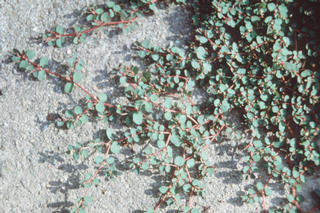Euphorbia humifusa
Contents
Nomenclature
Other Names:
Historical Use of Euphorbia humifusa
Euphorbia humifusa in Traditional Chinese Medicine
Background
Chinese Name (pinyin): Dijincao
Chinese Name :
Common Name :Creeping Euphorbia
Specific Name : Herba euphorbiae humifusae
Scientific Name:
Collection : The drug is collected in summer and autumn, removed from foreign matter and dried in the sun.
Description : Herb of Euphorbia humifusa: Frequently crumpled and curved, roots thin, stems thin, furcate branched, externally purplish-red, glabrous or sparsely white furry, texture fragile, fracture yellowish white. Hollowed in the center. Leaves simple, opposite with pale red, short petioles or almost sessile, lamina mostly crumpled or fallen off when whole. Long elliptic 5 - 10mm long, 4 - 6mm wide, green or purplish red, frequently glabrous or sparsely furry, apex obtusely rounded, base oblique, margin serrulated or slightly sinuous. Cup shaped cyme axillary, small. Capsules triangular-spherical, externally smooth, seeds small, ovoid, brown, odorless, taste slightly astringent.Herb of Euphorbia maculata: Leaves with red spots on the upper surface, capsules sparsely white furry.
Identification : Powder greenish brown, outer walls of the leaves epidermal cells papillary. Surrounding cells of the fine vein ends in mesophyll arranged radiately in circles. Non-glandular hairs 3 - 8 celled, about 14µm in diameter mostly broken. Non-articulate laticiferous tubes containing fine lamellar starch granules.
Processing : Eliminate foreign matter, spray with water, soften briefly, cut into sections and dry in the sun.
Action : To remove toxic heat and to arrest bleeding by reducing heat in blood.
Indication : dysentery colitis; hemoptysis; hematuria; hemotchezia, abnormal uterine bleeding; boils, carbuncles
Precautions :
Dosage : 9 to 20 g; or 30 to 60 g of the fresh herb; appropriate quantity for external use.
Storage : Preserve in a ventilated and dry place.
Nomenclature
Other Names:
Historical Use of Euphorbia humifusa
Euphorbia humifusa in Traditional Chinese Medicine
Background
Chinese Name (pinyin): Dijincao
Chinese Name :
Common Name :Creeping Euphorbia
Specific Name : Herba euphorbiae humifusae
Scientific Name:
Collection : The drug is collected in summer and autumn, removed from foreign matter and dried in the sun.
Description : Herb of Euphorbia humifusa: Frequently crumpled and curved, roots thin, stems thin, furcate branched, externally purplish-red, glabrous or sparsely white furry, texture fragile, fracture yellowish white. Hollowed in the center. Leaves simple, opposite with pale red, short petioles or almost sessile, lamina mostly crumpled or fallen off when whole. Long elliptic 5 - 10mm long, 4 - 6mm wide, green or purplish red, frequently glabrous or sparsely furry, apex obtusely rounded, base oblique, margin serrulated or slightly sinuous. Cup shaped cyme axillary, small. Capsules triangular-spherical, externally smooth, seeds small, ovoid, brown, odorless, taste slightly astringent.Herb of Euphorbia maculata: Leaves with red spots on the upper surface, capsules sparsely white furry.
Identification : Powder greenish brown, outer walls of the leaves epidermal cells papillary. Surrounding cells of the fine vein ends in mesophyll arranged radiately in circles. Non-glandular hairs 3 - 8 celled, about 14µm in diameter mostly broken. Non-articulate laticiferous tubes containing fine lamellar starch granules.
Processing : Eliminate foreign matter, spray with water, soften briefly, cut into sections and dry in the sun.
Action : To remove toxic heat and to arrest bleeding by reducing heat in blood.
Indication : dysentery colitis; hemoptysis; hematuria; hemotchezia, abnormal uterine bleeding; boils, carbuncles
Precautions :
Dosage : 9 to 20 g; or 30 to 60 g of the fresh herb; appropriate quantity for external use.
Storage : Preserve in a ventilated and dry place.
Synonymns for Euphorbia humifusa
Patent Medicines and Medicines with Multiple Ingredients that include Euphorbia humifusa
Pharmaceutical Information
Chemical Constituents
Evidence or the Use of Euphorbia humifusa in the Treatment of Epilepesy
Basic Science
Animal Studies
Cohort, Case-Control and Non-Randomized Trials
Randomized Controlled Trials
Meta-Analysis
1st Five Results: pubmed search
Xiying Wu, Hao-Wei Chen, Ze-Yu Zhao, Lisha Li, Chi Song, Juan Xiong, Guo-Xun Yang, Quangang Zhu, Jin-Feng Hu
##Title##
RSC Med Chem: 2024, 15(2);553-560
[PubMed:38389873]
[WorldCat.org]
[DOI]
(I e)
Ami Oh, Eun Su Kang, Dong-Chan Son, Soo-Rang Lee
##Title##
Mitochondrial DNA B Resour: 2024, 9(2);267-271
[PubMed:38348094]
[WorldCat.org]
[DOI]
(I e)
Sung-Gyu Lee, Hyun Kang
##Title##
J Microbiol Biotechnol: 2024, 34(2);387-398
[PubMed:37986586]
[WorldCat.org]
[DOI]
(I p)
Tojofaniry Fabien Rakotondrabe, Minxia Fan, Guangwan Hu, Mingquan Guo
Potential hemostatic compounds targeting urokinase plasminogen activator explored from three Euphorbiaceae species: Euphorbia maculata, Euphorbia humifusa, and Acalypha australis, with bio-affinity ultrafiltration UPLC-MS.
Phytochem Anal: 2024, 35(1);28-39
[PubMed:37571866]
[WorldCat.org]
[DOI]
(I p)
Mengya Ding, Xiaojie Wang, Jia Man, Jianyong Li, Yinghua Qiu, Yongqi Zhang, Maocheng Ji, Jianfeng Li
Antibacterial and hemostatic polyvinyl alcohol/microcrystalline cellulose reinforced sodium alginate breathable dressing containing Euphorbia humifusa extract based on microfluidic spinning technology.
Int J Biol Macromol: 2023, 239;124167
[PubMed:36963544]
[WorldCat.org]
[DOI]
(I p)
